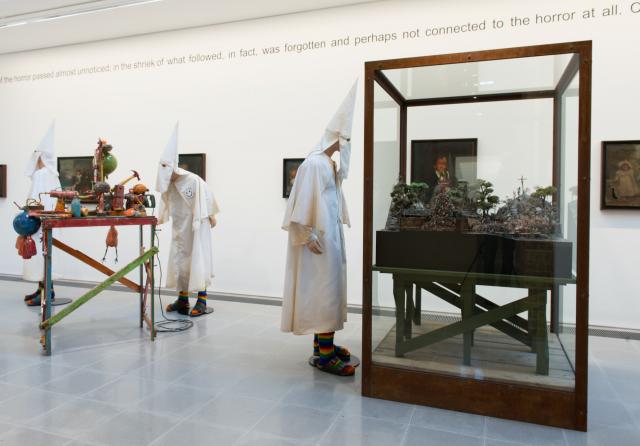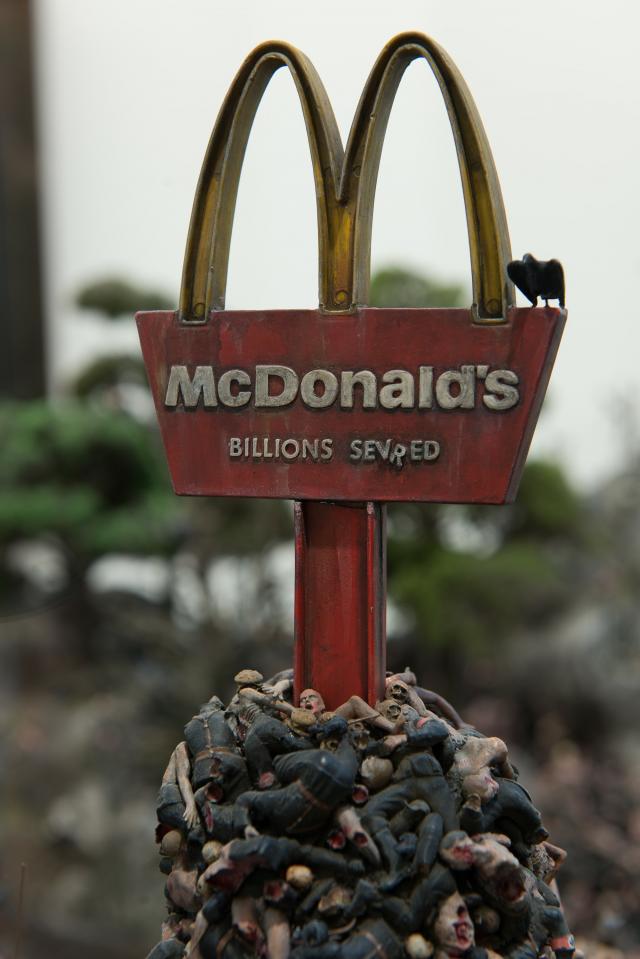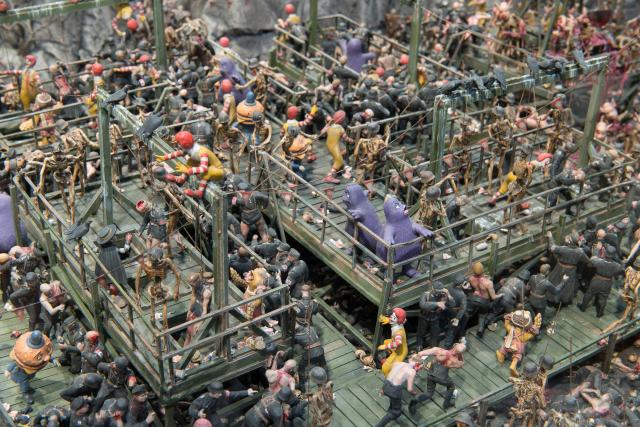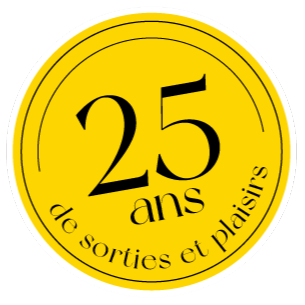
Shock schlock. Horror humour. A circus of sadism. Puerile purgatory. Gross out gulch.
There are many weird and wonderful ways to describe Jake and Dinos Chapman’s body of work. The brothers themselves have oft been described as the enfants terribles of the contemporary art world; the anti-Jeff Koonses, if you will. For years, North America has been kept safe from these notorious British sickos, but alas – no longer. Jake and Dinos have decided to violate our borders and lay waste to all that is pure and holy in an all-out bloody takeover of the DHC/ART Foundation. Days before the siege, Nightlife.ca tracked down Jake Chapman at a petrol station outside of London. Here’s what he had to say for himself.
Nightlife.ca: Let’s start off with an easy question: can you neuter horror with repetition? In a way, is the tautological barrage of terror in Come and See an attack on our culture of desensitization?
Jake Chapman: I don’t know about desensitization. I think we gravitate towards horror because it tells us about our relationship to entropy. By looking at infinite images of horror, death and mutilation, I don’t think it takes its symbolic meaning away. Our repetitious interest in horror is a vital interest. I don’t think it is to do with nullifying or minimizing the influence of death over our lives at all. That’s not how our observance of horror and images of transgression function.
 Jake and Dinos Chapman: Installation view, Come and See; Serpentine Sackler Gallery, London (© Hugo Glendinning)
Jake and Dinos Chapman: Installation view, Come and See; Serpentine Sackler Gallery, London (© Hugo Glendinning)
What about the life-sized Klansmen scattered throughout the exhibit? You kit them out in Birkenstocks and rainbow socks, have them peruse an art show, and give them a smiley face as their shared insignia. What’s going on here?
There’s something very interesting about the idea of facelessness. The idea of the mask. The KKK’s ideology is incredibly obvious, incredibly vulgar, and yet, they still have the need to mask their identity. Part of the fetishistic claim is their notion of purity, that somehow the white species have this unpollutable value, and yet at the same time, their identity has to be hidden. Also, we’re trying to mess around with the idea of who is the authentic viewer of this work of art – what kind of ideologies are being mixed up? How much of a libertarian is the person looking at this work of art? We’re teasing the notion that the viewer is this libertarian who believes that there is a harmonic relationship between the existential importance of themselves and the autobiographical meaning of the work. So I suppose, you know – we’re being a little mean about that.
You demand a lot of your audience, in terms of a strong stomach and an ability to laugh (mainly at themselves). Do you get your jollies out of punishing your viewers?
There’s a great quote from the writer Sacher-Masoch that says, “whips and furs are merely the means by which I terrorize myself.” In essence, one has to work out what kind of cultural forms one gravitates towards. Is it little watercolours and landscapes, or is it things that are more terrorizing in terms of their ability to extract a more active relationship from a work of art?
Speaking of flogging, let’s switch course from Venus in Furs to clowns in red shoes. Ronald McDonald pops up quite frequently in your work. McDonald’s seems like a bit of an easy target – is it?
You can plot the trajectory of McDonald's from this utopian, emancipatory attempt to feed the poor, to becoming the number one pariah for the disruption and the globalization of the world. It is interesting how the purveyor of this embryonic desire to feed everyone became public enemy number one. I suppose in some sense we’re enjoying this idiot blame being attached to a corporate culture that is no more corporate than anyone else. What’s interesting about the utopianism of McDonald’s is that it ends up being dystopian. Jake and Dinos Chapman: When the world ends, there’ll be no more air. That’s why it’s important to pollute the air now. Before it’s too late. After the end of the world, also, all the technological advances which have been made in this century, which could a this very moment allow a leisure society for all but a few technicians, and a few women with wombs, – so that there will, I mean there could, be no more social class – after the end of this world when humans are no more, the machines for human paradise will run on their own. Just as McDonald’s now runs. (Free Willy), 2012. Glass-fibre, plastic and mixed media; Courtesy of the Artists and White Cube (© Hugo Glendinning)
Jake and Dinos Chapman: When the world ends, there’ll be no more air. That’s why it’s important to pollute the air now. Before it’s too late. After the end of the world, also, all the technological advances which have been made in this century, which could a this very moment allow a leisure society for all but a few technicians, and a few women with wombs, – so that there will, I mean there could, be no more social class – after the end of this world when humans are no more, the machines for human paradise will run on their own. Just as McDonald’s now runs. (Free Willy), 2012. Glass-fibre, plastic and mixed media; Courtesy of the Artists and White Cube (© Hugo Glendinning)
I suppose fast food embodies many of the evils that are destroying the planet.
It’s really too late to be concerned about this, really, this whole “we somehow ruined the world” thing. There’s this fantastic global guilt, that somehow we did something wrong, that somehow we could have intentionally helped ourselves. I mean, the world works by species extinction. We live our lives like we have some effect on things, when in fact, we’re little squeaking nothings. People erroneously think that somehow, this suicidal trajectory of industrialization would’ve simply come to a grinding halt had someone suddenly decided that, “oh shit – we’ve gone too far!” Well, of course it’s gone too far, only because we’ve exploited all resources that were made available to us. But all creatures use up what they can. I mean, global warming started when the first men and women started rubbing sticks together, because they started producing heat. There’s no intentional evil or badness or malevolence that happened – we haven’t done anything wrong.
So we’re all just going to die, there’s nothing more to be done, we should all get used to it, case closed?
I’m just trying to give a scale to the idea of human life. Rather than be pessimistic about the end to humanity, we should wholly acknowledge the fact that we’re going extinct, and reach that conclusion with a sense of modesty – a sort of agreement to take our fate. Yet we still have this arrogance, because it’s backed up by either this notion that there’s a divine purpose to our existence – you know, that we’re greater than everything else – or there is a purpose devised by culture that will make us more civilized. The problem is, the more civilized we become, the more aware of existence we become. All this does is furnish us with a greater understanding of our pointlessness.
Why create anything then?
In a way, the knowledge of our inevitable end is the most torturous and masochistic bit of information that has plagued humanity. All this stuff that occurs between being born and dying, this kind of huge aggregate of cultural coral, is just a way to stem the inevitable. There’s nothing more or less to it, because there is nothing we can produce in our lives that makes any more sense of living or dying. Jake and Dinos Chapman: The Sum of all Evil, (detail) 2012–2013, Fibreglass, plastic and mixed media in four vitrines, Courtesy of the Artists and White Cube (© Hugo Glendinning)
Jake and Dinos Chapman: The Sum of all Evil, (detail) 2012–2013, Fibreglass, plastic and mixed media in four vitrines, Courtesy of the Artists and White Cube (© Hugo Glendinning)
Jake and Dinos Chapman: When the world ends, there’ll be no more air. That’s why it’s important to pollute the air now. Before it’s too late. After the end of the world, also, all the technological advances which have been made in this century, which could a this very moment allow a leisure society for all but a few technicians, and a few women with wombs, – so that there will, I mean there could, be no more social class – after the end of this world when humans are no more, the machines for human paradise will run on their own. Just as McDonald’s now runs. (Free Willy), 2012. Glass-fibre, plastic and mixed media; Courtesy of the Artists and White Cube (© Hugo Glendinning)
If all we want to do is stem the tide, why don’t we look the other way towards things that are life affirming? Why do we focus so intently on acts of violence and death? Violent video games, “torture porn” films, grizzly re-enactments on TV…
It is mesmerizing, this reiteration of death. It is one way of accounting for the enormity of what will happen to us. The existential, philosophical importance that we give ourselves, the way we account for all this strange secretion of culture could all be chalked up to this apprehension and comprehension of death. I mean, the difference between animals and us is that an animal is in the world like water in water – it has no sense of itself outside of its existence, no concept of finitude. The one thing that produces culture and all its notions for us is finitude. The problem though, is that when you watch people die serenely, the subtlety of slipping from one state to another gives us no information. There’s nothing that can be taken from that. Violence, on the other hand, screams information. In watching horror movies, we’re constantly trying to seek out the coordinates for death and dying. There’s no other rational way that can really give any return on our interest – that’s the problem. It’s a miserable existence, isn’t it?
So when it comes right down to it, nihilism should be everyone’s default modus operandi?
You can have a nihilism that is slightly joyful, like a happy pessimism. The point is not to get into this terrible phobic neurosis. You know – to just have this wider notion that there’s an inevitability to the end. What would be wrong with that? What would be wrong with saying, “okay – let’s be a little more cool about global warming, let’s be a little more chill about ‘heat death’.” Haha! Heat death! I like that. That’s brilliant!
Jake & Dinos Chapman: Come and See
From April 4 to August 31, 2014
DHC/ART | 451 & 465, St-Jean Street











